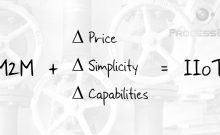* Originally published by Kent Herbst, President of ProcessEye, on LinkedIn.
It’s an amazing time we are living in. There has never been a period where things have changed and evolved at such a rapid pace. But lets’ face it, the big companies are dominating the smaller players in many areas. It used to be common for local communities to have a wide variety of small, family-owned businesses providing goods in our communities. This has progressively given way to larger organizations, like Walmart or Costco, moving in and leveraging their systems to overtake the smaller incumbents.
“But lets’ face it, the big companies are dominating the smaller players in many areas.”
Then came along the internet and ecommerce. In the beginning it was the early innovative providers that were able to capture most of the market share. But then, once again, the bigger players, like Amazon, move in and continue to capture more and more of the market, leaving little room for other suppliers.
This dynamic isn’t relegated to just the consumer marketplace. The industrial world has seen its share of dominance from the larger players as well. For example, companies like GE and Siemens have largely controlled the markets that they have played in and local parts houses and commodity providers have felt the pressure of the larger providers. In addition, the competition isn’t necessarily contained to domestic companies as there is stronger global competitive pressure.
So where does this leave small to mid-size companies in the industrial marketplace? Are they living on borrowed time…just waiting for obsolescence or to be acquired? If all they are providing are goods, then yes, that’s probably the reality. If they haven’t already recognized it, they will most likely succumb to the competitive advantage larger, more operationally efficient organizations have. Larger organizations have typically figured out how to squeeze out every wasted dollar to become the low-cost provider.
The only chance small to mid-size industrial companies have to survive in these dynamic times is to focus on the service aspect of their offering. Under most circumstances, good service can typically beat low cost. But even then, the small to mid-size companies are vulnerable. Why? Larger organizations are focused on the distinct advantage technology can provide. In the realm of industrial goods and services, technology enables better service at a lower cost.
“In the realm of industrial goods and services, technology enables better service at a lower cost.”
What does “technology” look like in the industrial service world? It takes on many forms, but generally it means hardware and software that delivers insight into systems and applications. Having insight into what’s going on enables a service provider to deliver more value to their customers. The value can be in the form of cost savings, improved safety, reduced downtime, etc. But it all starts at one point…data insight. The catch is getting that data insight has been complicated and expensive. However, that has changed with recent advancements (see ProcessEye).
If David, the small to mid-sized companies, are to beat Goliath, the larger more efficient organizations, they need to make the focus of leveraging technology their #1 business priority. Larger organizations have invested significant capital in developing systems to try and enable this competitive advantage. Small to mid-size companies need to use their primary competitive advantages…speed and adaptability…to figure out how to provide the best service by augmenting their people with the benefits technology provides.






